Water–Energy Nexus for Multi-Criteria Decision Making in Water Resource Management: A Case Study of Choshui River Basin in Taiwan
Abstract
1. Introduction
2. Materials and Methods
2.1. Study Area
2.2. Design of the MCDA
2.3. Current Practices for Water Resource Management
2.4. Determination of Overall Performance
2.4.1. Water-Supply Potential
2.4.2. Systemic Energy Efficiency
2.4.3. Economic Feasibility and Climate-Related Stability
3. Results and Discussion
3.1. Performance of the Practices
3.2. MCDA Results
4. Conclusions
Author Contributions
Funding
Acknowledgments
Conflicts of Interest
References
- Rothausen, S.G.S.A.; Conway, D. Greenhouse-gas emissions from energy use in the water sector. Nat. Clim. Chang. 2011, 1, 210–219. [Google Scholar] [CrossRef]
- DeNooyer, T.A.; Peschel, J.M.; Zhang, Z.; Stillwell, A.S. Integrating water resources and power generation: The energy-water nexus in Illinois. Appl. Energy 2016, 162, 363–371. [Google Scholar] [CrossRef]
- Lee, M.; Keller, A.A.; Chiang, P.C.; Den, W.; Wang, H.; Hou, C.H.; Wu, J.; Wang, X.; Yan, J. Water-energy nexus for urban water systems: A comparative review on energy intensity and environmental impacts in relation to global water risks. Appl. Energy 2017, 205, 589–601. [Google Scholar] [CrossRef]
- Ringler, C.; Bhaduri, A.; Lawford, R. The nexus across water, energy, land and food (WELF): Potential for improved resource use efficiency? Curr. Opin. Environ. Sustain. 2013, 5, 617–624. [Google Scholar] [CrossRef]
- Vieira, A.S.; Beal, C.D.; Ghisi, E.; Stewart, R.A. Energy intensity of rainwater harvesting systems: A review. Renew. Sustain. Energy Rev. 2014, 34, 225–242. [Google Scholar] [CrossRef]
- Plappally, A.K.; Lienhard, V.J.H. Energy requirements for water production, treatment, end use, reclamation, and disposal. Renew. Sustain. Energy Rev. 2012, 16, 4818–4848. [Google Scholar] [CrossRef]
- Kajenthira, A.; Siddiqi, A.; Anadon, L.D. A new case for promoting wastewater reuse in Saudi Arabia: Bringing energy into the water equation. J. Environ. Manag. 2012, 102, 184–192. [Google Scholar] [CrossRef] [PubMed]
- Lin, C.C.; Lin, J.Y.; Lee, M.; Chiueh, P.T. Sector-wise midpoint characterization factors for impact assessment of regional consumptive and degradative water use. Sci. Total Environ. 2017, 607–608, 786–794. [Google Scholar] [CrossRef] [PubMed]
- Chen, P.Y.; Huang, S.J.; Yu, C.Y.; Chiang, P.C.; Liu, T.M.; Tung, C.P. Study on the Climate Adaption Planning for an Industrial Company with Regional Risk of the Water Supply System—A Case in Taiwan. Water 2017, 9, 682. [Google Scholar] [CrossRef]
- Wang, H.F.; Sung, M.P.; Hsu, H.W. Complementarity and substitution of renewable energy in target year energy supply-mix planning—In the case of Taiwan. Energy Policy 2016, 90, 172–182. [Google Scholar] [CrossRef]
- Javanbarg, M.B.; Scawthorn, C.; Kiyono, J.; Shahbodaghkhan, B. Fuzzy AHP-based multicriteria decision making systems using particle swarm optimization. Expert Syst. Appl. 2012, 39, 960–966. [Google Scholar] [CrossRef]
- Scholten, L.; Scheidegger, A.; Reichert, P.; Mauer, M.; Lienert, J. Strategic rehabilitation planning of piped water networks using multi-criteria decision analysis. Water Res. 2014, 49, 124–143. [Google Scholar] [CrossRef] [PubMed]
- Alvarado, A.; Esteller, M.V.; Quentin, E.; Expósito, J.L. Multi-criteria decision analysis and GIS approach for prioritization of drinking water utilities protection based on their vulnerability to contamination. Water Resour. Manag. 2016, 30, 1549–1566. [Google Scholar] [CrossRef]
- Jaiswal, R.K.; Ghosh, N.C.; Galkate, R.V.; Thomas, T. Multi criteria decision analysis (MCDA) for watershed prioritization. Aquat. Procedia 2015, 4, 1553–1560. [Google Scholar] [CrossRef]
- Song, J.; Chung, E.S. A multi-criteria decision analysis system for prioritizing sites and types of low impact development practices: Case of Korea. Water 2017, 9, 291. [Google Scholar] [CrossRef]
- Zheng, J.; Egger, C.; Lienert, J. A scenario-based MCDA framework for wastewater infrastructure planning under uncertainty. J. Environ. Manag. 2016, 183, 895–908. [Google Scholar] [CrossRef] [PubMed]
- Lee, Y.J.; Tung, C.M.; Lee, P.R.; Lin, S.C. Personal Water Footprint in Taiwan: A Case Study of Yunlin County. Sustainability 2016, 8, 1112. [Google Scholar] [CrossRef]
- Cheng, C.L. Study of the inter-relationship between water use and energy conservation for a building. Energy Build. 2002, 34, 261–266. [Google Scholar] [CrossRef]
- Keeney, R.L.; Raiffa, H. Decisions with Multiple Objectives: Preferences and Value Tradeoffs; John Wiley: New York, NY, USA, 1976. [Google Scholar]
- Scholten, L.; Maurer, M.; Lienert, J. Comparing multi-criteria decision analysis and integrated assessment to support long-term water supply planning. PLoS ONE 2017, 14, e0176663. [Google Scholar] [CrossRef] [PubMed]
- Roberts, R.; Goodwin, P. Weight approximations in multi-attribute decision models. J. Multi-Criteria Decis. Anal. 2002, 11, 291–303. [Google Scholar] [CrossRef]
- WRA. Strengthening Water Supply System Adaptive Capacity to Climate Change in Central Region; Water Resources Planning Institute, Ed.; Water Resources Agency: Taichung, Taiwan, 2012. (In Chinese) [Google Scholar]
- WRA. Solution and Action Plan for Prevention of Land Subsidence in Changhua and Yunlin Counties; Water Resources Agency: Taichung, Taiwan, 2011. (In Chinese) [Google Scholar]
- Council of Agriculture. Golden Corridor Agricultural New Plan and Action Plan; Council of Agriculture: Taipei, Taiwan, 2013. (In Chinese) [Google Scholar]
- WRA. Regional Water Resource Planning for Central Taiwan; Water Resources Agency: Taichung, Taiwan, 2016. (In Chinese) [Google Scholar]
- Scharfy, D.; Boccali, N.; Stucki, M. Clean technologies in agriculture—How to prioritise measures? Sustainability 2017, 9, 1303. [Google Scholar] [CrossRef]
- Lee, M.; Tansel, B.; Balbin, M. Influence of residential water use efficiency measures on household water demand: A four year longitudinal study. Resour. Conserv. Recycl. 2011, 56, 1–6. [Google Scholar] [CrossRef]
- Jalilov, S.M.; Kefi, M.; Kumar, P.; Masago, Y.; Mishra, B. Sustainable urban water management: Application for integrated assessment in Southeast Asia. Sustainability 2018, 10, 122. [Google Scholar] [CrossRef]
- Fane, A.G. A grand challenge for membrane desalination: More water, less carbon. Desalination 2018, 426, 155–163. [Google Scholar] [CrossRef]
- Pereira, L.S.; Oweis, T.; Zairi, A. Irrigation management under water scarcity. Agric. Water Manag. 2002, 57, 175–206. [Google Scholar] [CrossRef]
- Mankad, A.; Tapsuwan, S. Review of socio-economic drivers of community acceptance and adoption of decentralized water systems. J. Environ. Manag. 2011, 92, 380–391. [Google Scholar] [CrossRef] [PubMed]
- Fielding, K.S.; Gardner, J.; Leviston, Z.; Price, J. Comparing public perceptions of alternative water sources for potable use: The case of rainwater, stormwater, desalinated water, and recycled water. Water Resour. Manag. 2015, 29, 4501–4518. [Google Scholar] [CrossRef]
- Lin, W.S.; Lee, M.; Huang, Y.C.; Den, W. Identifying water recycling strategy using multivariate statistical analysis for high-tech industries in Taiwan. Resour. Conserv. Recycl. 2015, 94, 35–42. [Google Scholar] [CrossRef]
- Lu, B.S.; Lee, M.; Chen, S.T.; Chen, C.H.; Luo, Y.C.; Den, W. Strategic optimization of water reuse in wafer fabs via multi-constraint linear programming technique. Water-Energy Nexus 2018, 1, 86–96. [Google Scholar] [CrossRef]
- Kenney, D.S.; Wilkinson, R. The Water-Energy Nexus in the American West; Edward Elgar Publishing: Cheltenham, UK, 2011. [Google Scholar]
- Hardy, L.; Garrido, A.; Juana, L. Evaluation of Spain’s water-energy nexus. Int. J. Water Resour. Dev. 2012, 28, 151–170. [Google Scholar] [CrossRef]
- Kenway, S.J.; Priestley, A.; Cook, S.; Seo, S.; Inman, M.; Gregory, A.; Hall, M. Energy Use in the Provision and Consumption of Urban Water in Australia and New Zealand; CSIRO—Water for a Healthy Country Flagship: Canberra, Australia, 2008. [Google Scholar]
- Elimelech, M.; Phillip, W.A. The future of seawater desalination: Energy, technology, and the environment. Science 2011, 333, 712–717. [Google Scholar] [PubMed]
- Cook, S.; Sharma, A.K.; Gurung, T.R. Evaluation of alternative water sources for commercial buildings: A case study in Brisbane, Australia. Resour. Conserv. Recycl. 2014, 89, 86–93. [Google Scholar] [CrossRef]
- Haque, M.M.; Rahman, A.; Samali, B. Evaluation of climate change impacts on rainwater harvesting. J. Clean. Prod. 2016, 137, 60–69. [Google Scholar] [CrossRef]
- Ferrand, E.A. Rainwater Harvesting as an Effective Climate Change Adaptation Strategy in Rural and Urban Settings. In Managing Water Resources under Climate Uncertainty: Examples from Asia, Europe, Latin America, and Australia; Shrestha, S., Anal, A.K., Salam, P.A., van der Valk, M., Eds.; Springer International Publishing: Cham, Switzerland, 2015; pp. 405–420. [Google Scholar]
- Fallon, P.; Betts, R. Climate impacts on European agriculture and water management in the context of adaptation and mitigation The importance of an integrated approach. Sci. Total Environ. 2010, 408, 5667–5687. [Google Scholar] [CrossRef] [PubMed]
- Singh, A.; Panda, S.N. Development and application of an optimization model for the maximization of net agricultural return. Agric. Water Manag. 2012, 115, 267–275. [Google Scholar] [CrossRef]
- Wakeel, M.; Chen, B.; Hayat, T.; Alsaedi, A.; Ahmad, B. Energy consumption for water use cycles in different countries: A review. Appl. Energy 2016, 178, 868–885. [Google Scholar] [CrossRef]
- Quist-Jensen, C.A.; Macedonio, F.; Drioli, E. Membrane technology for water production in agriculture: Desalination and wastewater reuse. Desalination 2015, 364, 17–32. [Google Scholar] [CrossRef]
- Xi, X.; Poh, K.L. Using system dynamics for sustainable water resources management in Singapore. Procedia Comput. Sci. 2013, 16, 157–166. [Google Scholar] [CrossRef]
- Konikow, L.F.; Kendy, E. Groundwater depletion: A global problem. Hydrol. J. 2005, 13, 317–320. [Google Scholar] [CrossRef]
- Barlow, P.M.; Reichard, E.G. Saltwater intrusion in coastal regions of North America. Hydrol. J. 2010, 18, 247–260. [Google Scholar] [CrossRef]
- Romano, G.; Salvati, N.; Guerrini, A. Estimating the determinants of residential water demand in Italy. Water 2014, 6, 2929. [Google Scholar] [CrossRef]
- Lee, M.; Tansel, B. Water conservation quantities vs customer opinion and satisfaction with water efficient appliances in Miami, Florida. J. Environ. Manag. 2013, 128, 683–689. [Google Scholar] [CrossRef] [PubMed]
- Giusti, E.; Marsili-Libelli, S. A fuzzy decision support system for irrigation and water conservation in agriculture. Environ. Model. Softw. 2015, 63, 73–86. [Google Scholar] [CrossRef]
- Levidow, L.; Zaccaria, D.; Maia, R.; Vivas, E.; Todorovic, M.; Scardigno, A. Improving water-efficient irrigation: Prospects and difficulties of innovative practices. Agric. Water Manag. 2014, 146, 84–94. [Google Scholar] [CrossRef]
- Das, B.; Singh, A.; Panda, S.N.; Yasuda, H. Optimal land and water resources allocation policies for sustainable irrigated agriculture. Land Use Policy 2015, 42, 527–537. [Google Scholar] [CrossRef]
- Chhipi-Shrestha, G.; Rodriguez, M.; Sadiq, R. Selection of sustainable municipal water reuse applications by multi-stakeholders using game theory. Sci. Total Environ. 2019, 650, 2512–2526. [Google Scholar] [CrossRef] [PubMed]
- Ghisi, E.; Rupp, R.F.; Triska, Y. Comparing indicators to rank strategies to save potable water in buildings. Resour. Conserv. Recycl. 2014, 87, 137–144. [Google Scholar] [CrossRef]
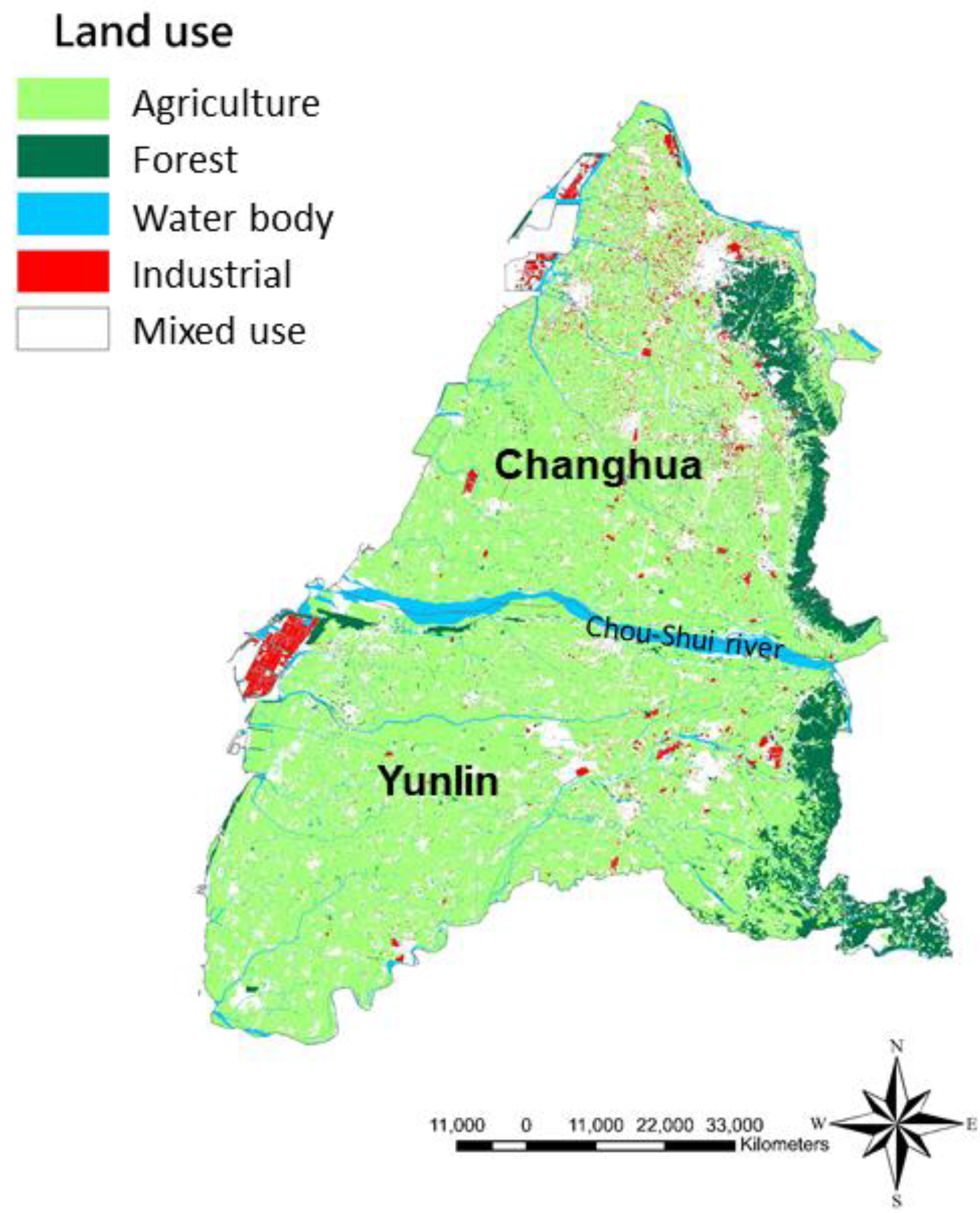
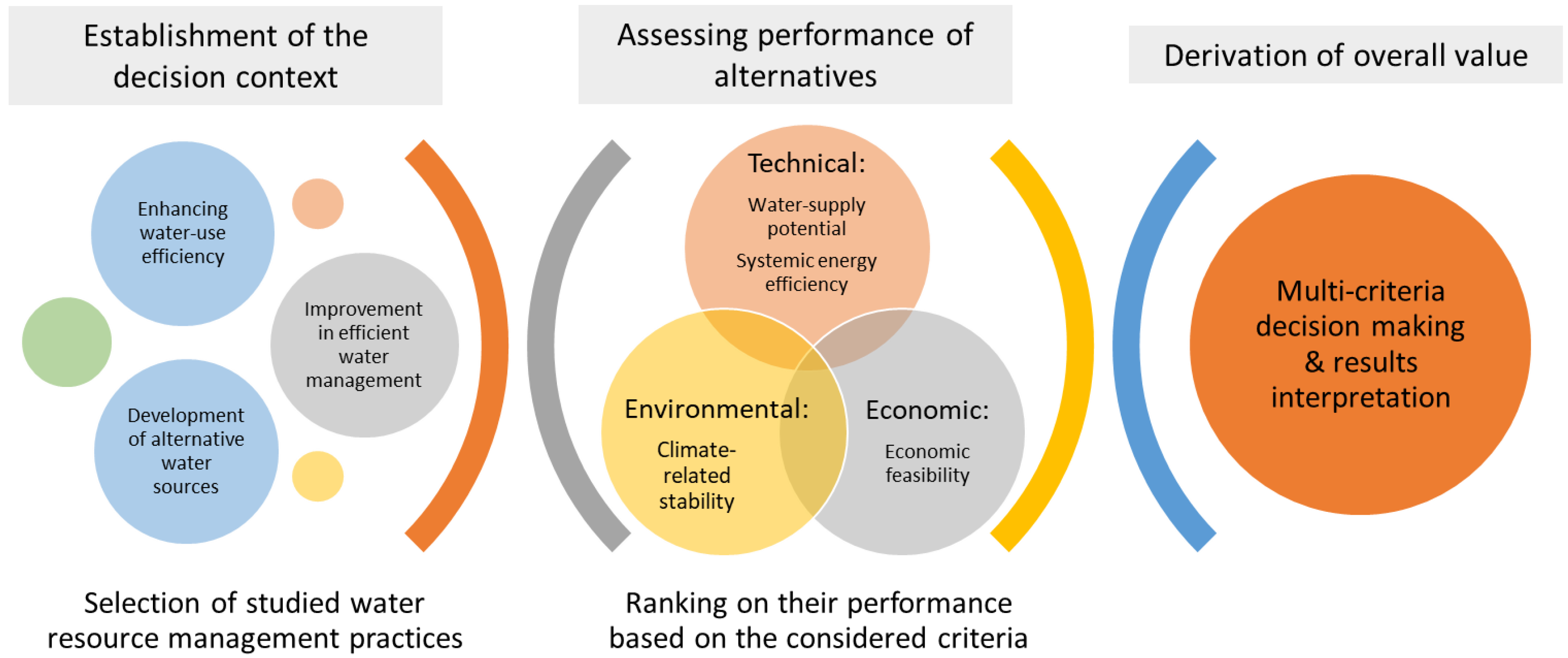
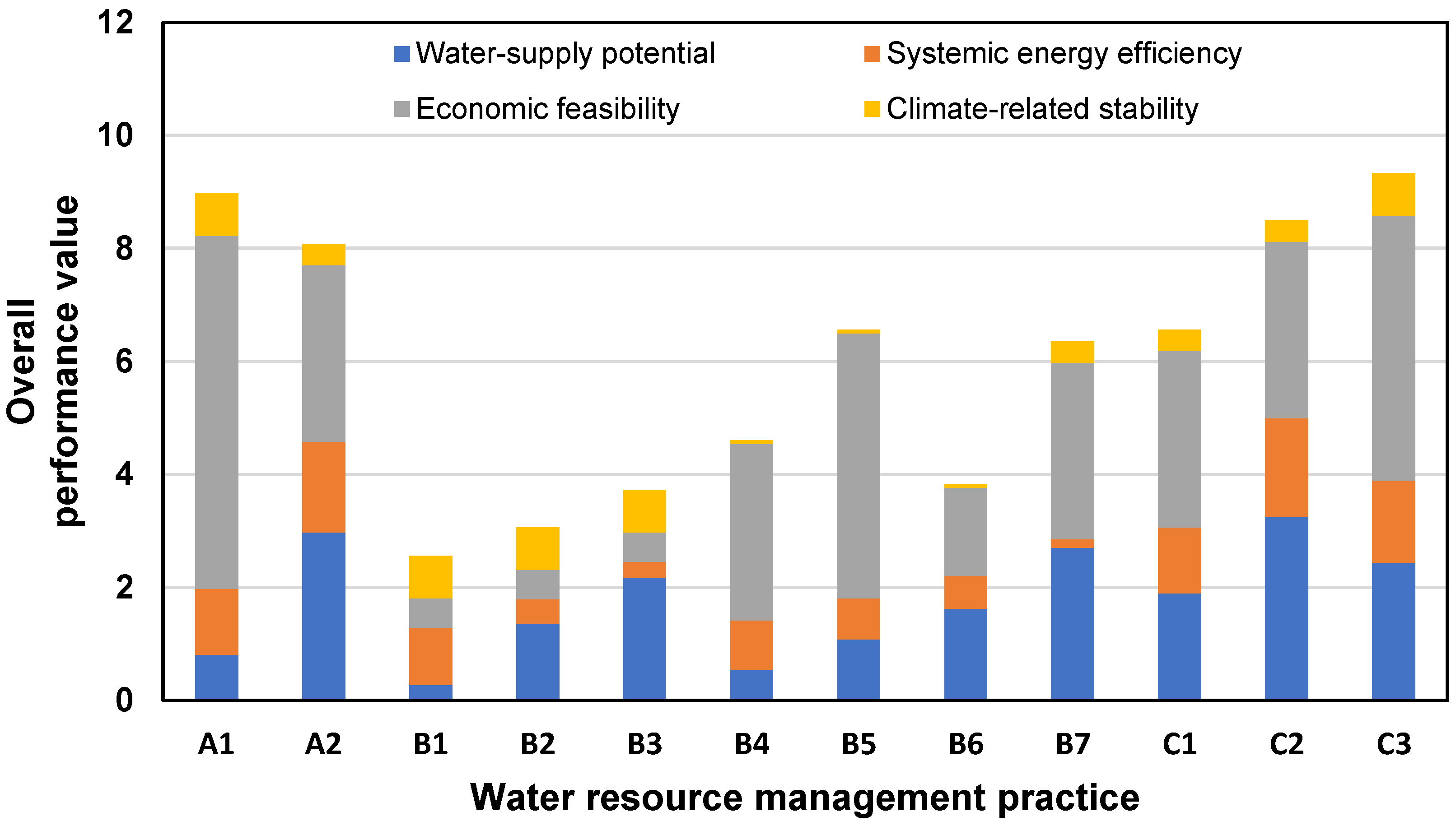
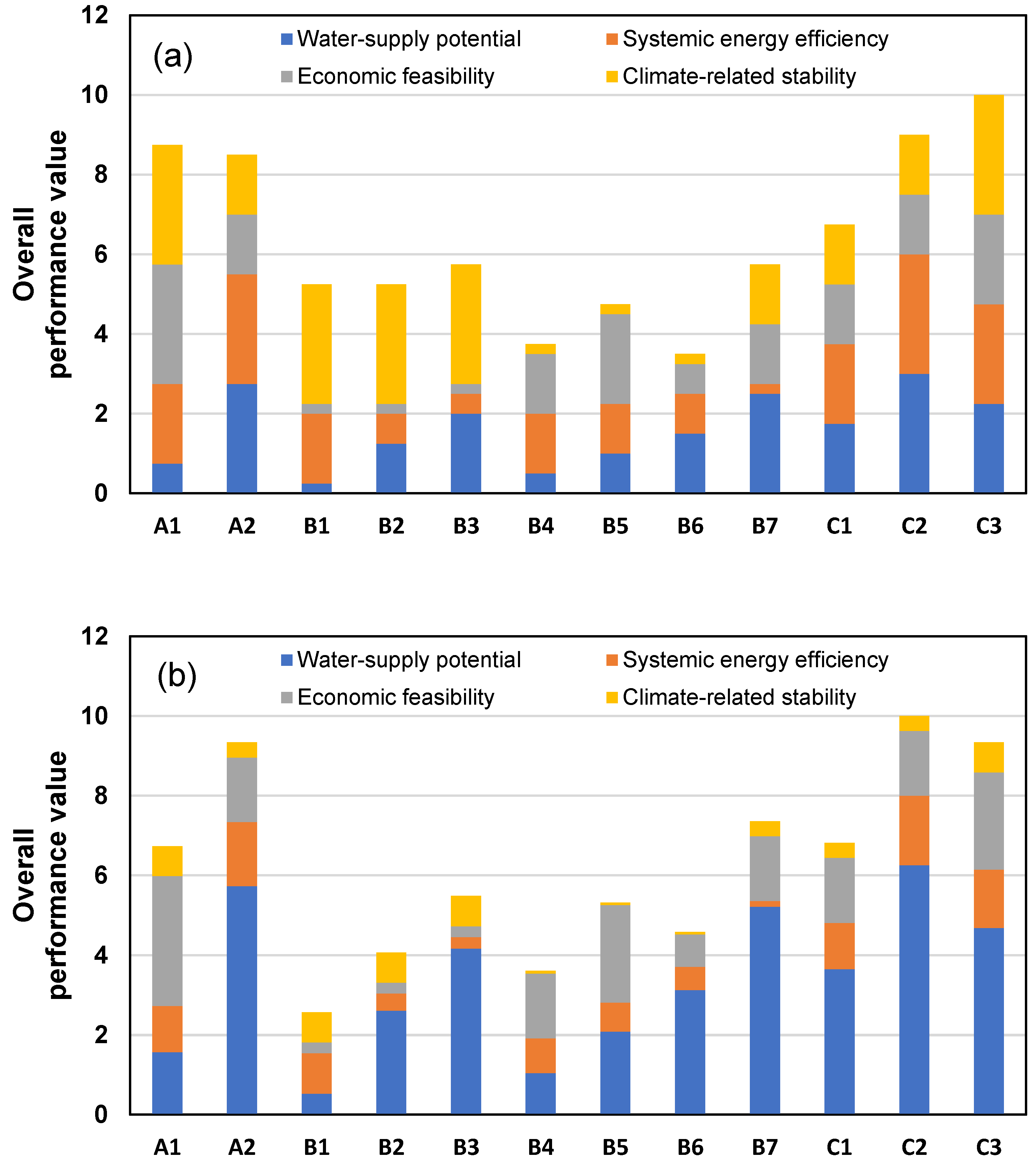
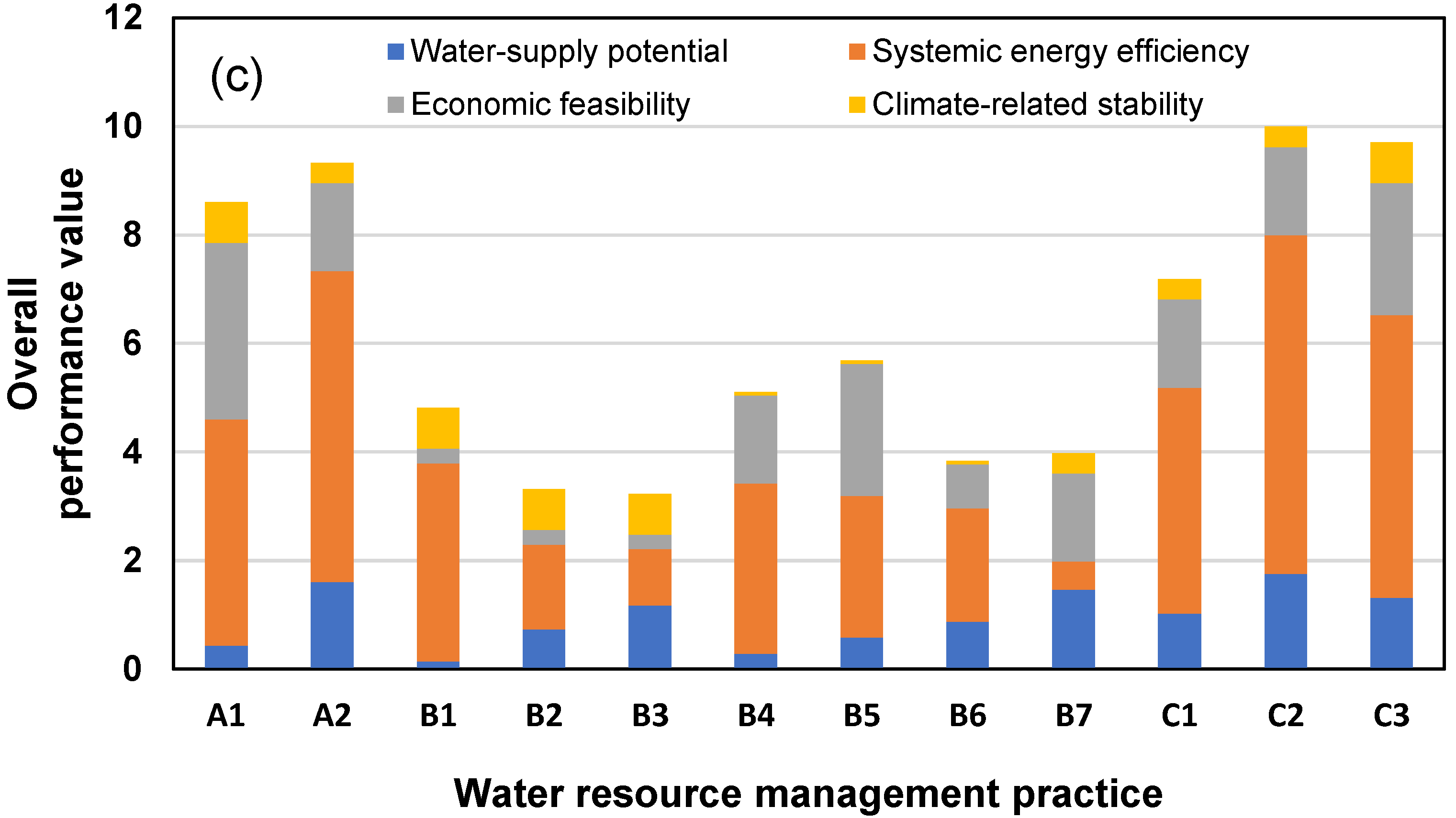
| Classification | Water Resource Management Practices | Abbreviation | Properties |
|---|---|---|---|
| Enhancing water-use efficiency | Water conservation program for residential sector (Yunlin County) | A1 | Improvement in water use efficiency in residential sector, to meet the 2030 Agenda for Sustainable Development Goals of United Nations. The average per capita water consumption in Yunlin County is 242 L per capita per day. It is expected that the water conservation program can provide 20L per capita per day of water saving. The Changhua County has shown effective water use and no further saving could be obtained [23]. |
| Water conservation program for agriculture sector | A2 | Agricultural production is the major economic activity in the study region, which accounts for a great portion of the overall water demand. Improvement in water use efficiency in agriculture sector, to meet the 2030 Agenda for Sustainable Development Goals of United Nations. Calculation on the water saving or water-supply potential is assumed at 2000 m3/ha in average [24]. The main economic crop in the study region is paddy rice. | |
| Development of alternative water sources | Domestic wastewater reclamation | B1 | Reclamation of secondary effluent from domestic wastewater treatment plants. Determination on the water-supply potential is based on the quantity of wastewater effluents and water recovery rate. The water recovery rate is assumed at 80% for conventional wastewater reclamation technology. |
| Industrial wastewater reclamation | B2 | Reclamation of industrial wastewater. The reclaimed water can be directly used on-site as source water or for secondary use. The reclamation was determined based on the actual data from a major manufacture in the study region. | |
| Seawater desalination | B3 | A company-owned seawater desalination plant was proposed at a capacity of 100,000 m3/year [22]. The main process for desalination is membrane-based reverse osmosis with energy recovery device (i.e., less energy consumption as compared to conventional ones). | |
| Rainwater harvesting from flood detention pond | B4 | Establishment of rainwater harvesting system for collecting available rainwater using flood detention ponds [23]. Estimation on the harvested rainwater is based on average daily precipitation, available area for rainwater catchment, and probability of precipitation. | |
| Rainwater harvesting from installation of engineered catchment system (company-owned) | B5 | Establishment of rainwater harvesting system for collecting available rainwater. This company-owned system collects rainwater for cooling or secondary uses. This system is a flexible and low-cost decentralized measure with relatively small impacts to the ecosystem [9]. | |
| Rainwater harvesting from installation of engineered catchment system (using public land area) | B6 | Establishment of rainwater harvesting system for collecting available rainwater. Estimation on the harvested rainwater is based on average daily precipitation, available area for rainwater catchment and probability of precipitation. The collected rainwater is aimed for secondary use. | |
| Irrigation return water reusing | B7 | Reuse of agricultural return water. The amount of reuse was proportional to agricultural water demand [23,24]. | |
| Improvement in effective water management | Aged pipelines replacement | C1 | Replacement of aged pipelines to lower the possibility of leakage [25]. The leakage rate in Taiwan is about 16% in average. |
| Leakage rate reduction for agricultural irrigation canals | C2 | Reducing leakage rate from long irrigation canals. The rate is proportional to the length of canals [23,24]. | |
| Improved monitoring and management of groundwater pumping | C3 | Improvement in monitoring of wells to reduce and manage inappropriate groundwater overpumping [23]. |
| Classification | Criteria | Description |
|---|---|---|
| Technical | Water-supply potential | Potential for increasing quantity of water supply or reducing water demand, thus, reducing the pressure on the water supply system. This could be done by increasing alternative water sources or conserving water use. Higher water-supply potential is preferred. |
| Systemic energy efficiency | Implementation of water resource management practices may contribute to increase in systemic energy demand. Lower increment on the energy demand (or higher energy efficiency) of the water supply system is preferred. | |
| Economic | Economic feasibility | Feasibility of monetary investment to the implementation of water resource management practices. It is closely related to the practice project’s scale, as costly development on a national or regional scale may not be economically feasible for practical implementation [31]. Therefore, higher economic feasibility on the practice is preferred. |
| Environmental | Climate-related stability | Stability from the influences of climate change. For instance, the volume of rainwater harvesting is strongly affected by climate condition, whereas desalination and wastewater reclamation plants are less affected by climate change [3]. |
| County | Agricultural | Forest | Transportation/Communication | Water Utilities | Buildings | Public Use | Recreation | Mining | Others | Total Population |
|---|---|---|---|---|---|---|---|---|---|---|
| Yunlin | 834.7 | 117.1 | 80.7 | 138.4 | 109.9 | 13.0 | 4.6 | 1.3 | 99.9 | 688,559 |
| Changhua | 637.5 | 85.3 | 75.1 | 130.6 | 151.7 | 13.6 | 7.1 | 0.9 | 142.8 | 1,278,945 |
| Total | 1472.2 | 202.4 | 155.8 | 269.0 | 261.7 | 26.5 | 11.7 | 2.2 | 242.7 |
| Performance Rating | Economic Feasibility | Climate-Related Stability |
|---|---|---|
| 1 | Very low | Strong impact |
| 3 | Low | - |
| 6 | Average | Slight impact |
| 9 | High | - |
| 12 | Very high | No impact |
| Classification | Water Resource Management Practices | Calculation/Assumption | Water-Supply Potential (10,000 m3/year) e | Performance Ranking for MCDA f |
|---|---|---|---|---|
| Enhancing water-use efficiency | A1 Water conservation program for residential sector (Yunlin County) a | 20 L/capita-day | 502.6 | 3 |
| A2 Water conservation program for agriculture sector b | 2000 m3/ha | 22,500 | 11 | |
| Development of alternative water sources | B1 Domestic wastewater reclamation d | 3,600 m3/day at 80% water recovery rate | 105 | 1 |
| B2 Industrial wastewater reclamation b | 17,300 m3/day | 630 | 5 | |
| B3 Seawater desalination a | company-owned at 100,000 m3/year | 3650 | 8 | |
| B4 Rainwater harvesting from flood detention pond b | - | 390 | 2 | |
| B5 Rainwater harvesting from installation of engineered catchment system (in a local company) d | 17,000 m3/day | 620.5 | 4 | |
| B6 Rainwater harvesting from installation of engineered catchment system (using public land area) d | 22,076 m3/day | 805.8 | 6 | |
| B7 Irrigation return water reusing b | 1,100,000 m3/day at 50% recovery rate | 20,000 | 10 | |
| Improvement in effective water management | C1 Aged pipelines replacement c | reduce leakage by 5% | 1000 | 7 |
| C2 Leakage rate reduction for agricultural irrigation canals b | 70 m3/m/year | 65,500 | 12 | |
| C3 Improved monitoring and management of groundwater pumping b | - | 17,100 | 9 |
| Classification | Water Resource Management Practices | Calculation/Assumption | Specific Energy Demand (kWh/m3) | Change in Annual Systemic Energy Demand (10,000 kWh/yr) g | Performance Ranking for MCDA h |
|---|---|---|---|---|---|
| Enhancing water-use efficiency | A1 Water conservation program for residential sector (Yunlin County) a | provides water and energy savings es | varies f | * | 8 |
| A2 Water conservation program for agriculture sector b | provides water and energy savings e | varies f | ** | 11 | |
| Development of alternative water sources | B1 Domestic wastewater reclamation d | for industrial use (tertiary treatment) | 2.14 | +225 | 7 |
| B2 Industrial wastewater reclamation b | for industrial process use (cascade wastewater streams) | 1.5 | +945 | 3 | |
| B3 Seawater desalination a | RO+ERD e | 3.1 | +11,315 | 2 | |
| B4 Rainwater harvesting from flood detention pond b | 0.58–1.7 kWh/m3 | 1.0 | +360 | 6 | |
| B5 Rainwater harvesting from installation of engineered catchment system (in a local company) d | 0.58–1.7 kWh/m3 | 1.0 | +620.5 | 5 | |
| B6 Rainwater harvesting from installation of engineered catchment system (using public land area) d | 0.58–1.7 kWh/m3 | 1.0 | +805.8 | 4 | |
| B7 Irrigation return water reusing b | for secondary use | 1.1 | +22,000 | 1 | |
| Improvement in effective water management | C1 Aged pipelines replacement c | provides water and energy savings e | ─ | * | 8 |
| C2 Leakage rate reduction for agricultural irrigation canals b | provides water and energy savings e | ─ | *** | 12 | |
| C3 Improved monitoring and management of groundwater pumping b | provides water and energy savings | ─ | ** | 10 |
© 2018 by the authors. Licensee MDPI, Basel, Switzerland. This article is an open access article distributed under the terms and conditions of the Creative Commons Attribution (CC BY) license (http://creativecommons.org/licenses/by/4.0/).
Share and Cite
Lee, M.; Yu, C.-Y.; Chiang, P.-C.; Hou, C.-H. Water–Energy Nexus for Multi-Criteria Decision Making in Water Resource Management: A Case Study of Choshui River Basin in Taiwan. Water 2018, 10, 1740. https://doi.org/10.3390/w10121740
Lee M, Yu C-Y, Chiang P-C, Hou C-H. Water–Energy Nexus for Multi-Criteria Decision Making in Water Resource Management: A Case Study of Choshui River Basin in Taiwan. Water. 2018; 10(12):1740. https://doi.org/10.3390/w10121740
Chicago/Turabian StyleLee, Mengshan, Chia-Yii Yu, Pen-Chi Chiang, and Chia-Hung Hou. 2018. "Water–Energy Nexus for Multi-Criteria Decision Making in Water Resource Management: A Case Study of Choshui River Basin in Taiwan" Water 10, no. 12: 1740. https://doi.org/10.3390/w10121740
APA StyleLee, M., Yu, C.-Y., Chiang, P.-C., & Hou, C.-H. (2018). Water–Energy Nexus for Multi-Criteria Decision Making in Water Resource Management: A Case Study of Choshui River Basin in Taiwan. Water, 10(12), 1740. https://doi.org/10.3390/w10121740






